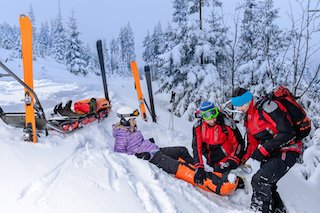A snowboarder heading down an intermediate run at Keystone Resort in Colorado last winter recklessly runs into a skier visiting from Chicago below him, causing a joint separation injury that kept him from working for three months in his job with the Chicago Fire Department.
A civil trial eventually ensues, and a jury in Keystone’s Summit County recently found the snowboarder was negligent in causing the accident and ordered him to pay $263,454 in damages to the man he injured.
How is this guy going to come up with $263,454 to pay the plaintiff? He doesn’t have to – his homeowner’s insurance policy will cover it.
Here in Ski Country USA, we hear about injury-causing collisions at Colorado ski resorts on a fairly regular basis during the winter months. But I rarely thought about what happens when the injured party sues the party causing the accident.
The victim in this particular case was represented by a personal injury law firm based in Denver that specializes in cases involving collisions at ski resorts. The lawyer in this case, Evan Banker of Chalet Law, told Colorado Public Radio in a Nov. 29 interview that his firm will only pursue a civil case against a skier or snowboarder if that person has homeowners or renters insurance.
Makes sense – you can’t get blood from a turnip, after all. Mortgage lenders push for coverage like this, because if the homeowner didn’t have this type of liability coverage and was at fault in an accident, there could be a lien put on the house. Interestingly, Banker also said a lot of the cases his firm handles could likely have been avoided altogether if the offending party would have simply apologized and offered assistance to the injured party right after the collision occurred.
Before hearing about this case, I didn’t realize homeowners insurance would cover a person’s liability in a situation such as this – and I’d bet most people have no idea. It got me to thinking about other surprising situations where homeowners or renters policies could come to the rescue.
We think of it as protecting your house and belongings in the event of something like fire or theft, but it does so much more that clients rarely consider. Homeowners and renters coverages are basically general liability policies that cover a wide range of events or activities completely unrelated to a policyowner’s home.
For example, much like the previously mentioned snowboarder, if you were to be riding a bicycle and you accidentally run into and injure a pedestrian, your homeowners or renters policy would likely cover you – even if the incident happened thousands of miles from your covered home.

Here are a few other examples:
• Dog bites: If your dog bites and injures someone, your homeowners or renters policy would likely cover it. Dog bites accounted for more than one-third of all homoeowners liability payouts in 2014, according to the Insurance Information Institute, and the average cost paid out for a dog bite claim was $32,072 in the U.S. in 2014. Most homeowners policies provide $100,000 to $300,000 in liability coverage, according to the I.I.I.
• Libel & Slander: A homeowners or renters policy’s liability coverage may very well apply when a client is sued for a variety of claims, including unintentional oral or written libel or slander. An umbrella policy on top of a homeowners policy may also be helpful in terms of covering excessive claims that exceed homeowners limits, and can also protect against defamation of character, wrongful imprisonment, invasion of privacy and defense costs in the event of a lawsuit.
• Refrigerated items: If a power outage spoils the food in a policyowner’s refrigerator and freezer, for example, the insured may be covered for the cost of replacing those items.
• Falling objects: Damage caused by falling objects, including satellites falling back to earth, is covered by standard homeowners insurance for damage to the property and contents within.
A couple of things that aren’t covered which many homeowners assume would be is flood or earthquake damage. While tornadoes, hurricanes and wildfires are typically covered by traditional homeowners insurance, these two types of natural disasters are not. Flood insurance is a separate type of coverage available through the National Flood Insurance Program, and the I.I.I. estimates 13% of U.S. homeowners have it. Basic homeowners coverage also won’t pay for damage caused by an earthquake. The I.I.I. estimates that only 7% of U.S. homeowners have earthquake insurance – and it’s only 12% in earthquake-prone California.
Thoughts, comments or first-hand experience dealing with situations like these? Please share on this thread: Uncommon uses for homeowners coverage













